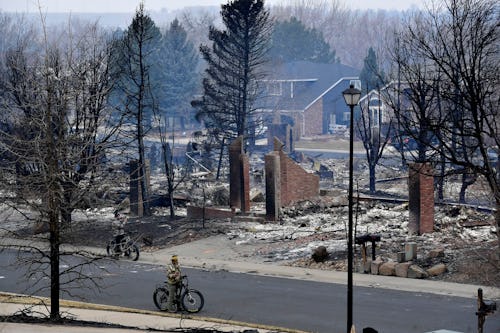
People in the suburbs of Denver, Colorado, are starting the year with a bizarre, tragic sight: snow-covered roads in Boulder County running through residential areas where the homes have been abandoned and destroyed. On Thursday, Dec. 30, an out-of-control fire started burning and quickly blew through the nearby towns of Superior and Louisville. The threat presented by the massive blaze forced tens of thousands of people to evacuate; so far, the flames have destroyed more than 1,000 houses and injured at least seven people. Three people were reported missing and are feared to have died in the fires.
The origins of the fire are still unknown, though authorities appear to have suspicions. Some have reported that the flames were the result of downed power lines, but the Boulder Office of Emergency Management says that is unlikely. According to USA Today, local authorities are investigating the cause and have a search warrant for a home in a neighborhood to the west of the towns that were destroyed by the fires. Videos submitted by tipsters and local residents reportedly show a shed burning nearby, though it is not clear if that’s the point of origin for the uncontrolled burn or if it is unrelated.
Regardless of how the fire started, we have a pretty good idea of how it spread. Despite cold weather and snowfall in the Denver area, which did help to eventually slow the flames, strong wind gusts of up to 100 miles per hour and dry grassy areas provided fuel to keep the fire burning. Colorado has been experiencing an ongoing and record-setting drought, posting the driest six-month stretch in the state’s recorded history. It was preceded by an unseasonably wet spring, which caused grassy areas to grow beyond their normal levels. More grass, which then dried out over the next six months, turned into an excessive amount of kindling — ready to carry a fire just like this one.
Brush fires in the winter are still rare, and when they do happen, they often occur outside of residential areas. This appeared to be a perfect storm of point of origin bringing the fire close to people and outlier weather conditions, likely caused by a changing climate, that spread the blaze quickly. Officials reported 40-foot flames covering full football field-lengths of grass in a matter of minutes as the fire spread.
The blaze has now engulfed more than 6,000 acres of land, much of which was in residential areas. Houses and businesses have been destroyed, and the fact that so few people were hurt or missing has been described by Colorado Gov. Jared Polis (D) as a “New Year’s miracle.”
Yet despite the silver lining of minimal deaths, the devastation of these fires can’t be downplayed. In terms of residencies lost, it is the most destructive fire in the history of the state. Colorado has declared a state of emergency due to the fires, and the Biden administration issued a disaster declaration in response to the destruction, extending federal aid and support to rebuild and recover.
The fires serve as a grim beginning to a new year, reminding us that the calendar flipping doesn’t mean we leave our mistakes in the past. We will be living with disasters like this one until we truly address the climate crisis.







